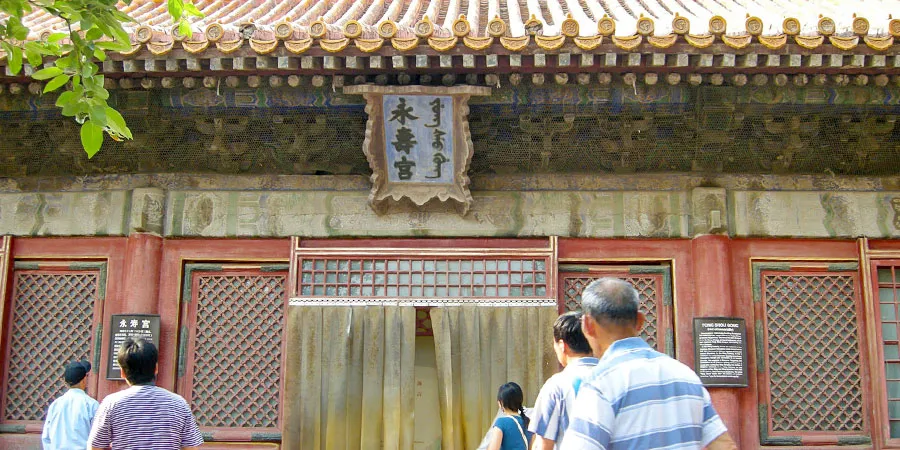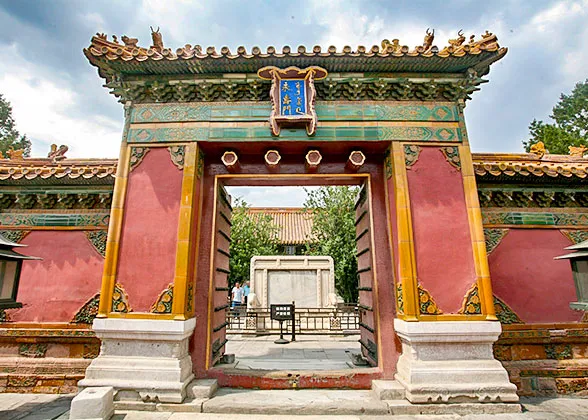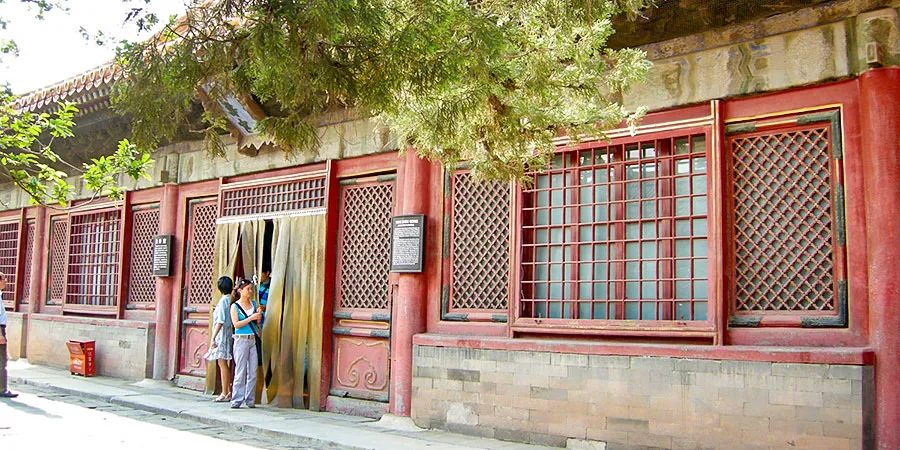Palace of Eternal Longevity (Yongshougong)
The Palace of Eternal Longevity, one of the Six Western Palaces in Forbidden City's Inner Court, is where the emperor's concubines lived from 15th to 19th century.
The layout of the Palace looks like Chinese character "日". The front yard has a main hall with 5 rooms and yellow glazed tile roof, with three side rooms on the east and west. In the backyard, the layout is similar, where a central hall and six side rooms exist, with a well located at the southeast corner.
Located close to the emperor's resting palace (Palace of Heavenly Purity and Hall of Mental Cultivation), it was home to many of his beloved ones, each with their own stories and secrets.
From its completion in 1420 to 1535, the building was called the Palace of Perpetual Joy, during which the emperor’s concubines would live here.
 Palace Secret: An Unexpected Emperor's Favor – Concubine Ji
Palace Secret: An Unexpected Emperor's Favor – Concubine Ji
Concubine Ji, originally an official in charge of the Forbidden City's inner court collections, caught Emperor Chenghua's (1447~1487) eye during an occasional visit. Impressed by her talent, he took her into his favor, leading to her pregnancy.
Her pregnancy sparked jealousy from Consort Wan (1430~1487), who ordered maids to abort the child. However, the sympathetic maids helped Ji to hide the pregnancy. In secret, Ji gave birth and raised her son until he was five. When Chenghua learned of his son, he moved Ji to the Palace of Perpetual Joy, where she lived for just a month and passed away later, possibly poisoned by Wan.
This palace was renamed as "Cultivating Virtue" in 1535. During 1600s, it served as the residence of Emperor Wanli (1563~1620), an incompetent ruler of the Ming Dynasty.
In 1616, it was renamed "Eternal Longevity", a name it retained thereafter. Undergoing repairs in 1655, 1697, and 1897, it has maintained most of its Ming Dynasty structure till now.
From its last renaming to the end of Qing Dynasty (1644~1911), the Palace was used as concubines' residence, princesses' wedding banquet venue and then the imperial storage.
 1650s: Concubine Jing's Tragic Downfall
1650s: Concubine Jing's Tragic Downfall
Concubine Jing was originally the Empress of Emperor Shunzhi (1638~1661). However, in 1653, she was deposed and downgraded to the rank of concubine, relocating to the Palace of Eternal Longevity.
Concubine Jing was deposed for three main reasons. Firstly, she was appointed Empress by Regent Dorgon (1612~1650) for the young Emperor Shunzhi, against Shunzhi’s own wishes. Secondly, despite her beauty, she harbored intense jealousy towards other attractive concubines, often causing disputes with Shunzhi and disrupting his personal life. Thirdly, raised in a privileged Mongolian aristocratic family, she had a taste for luxury, demanding pearls and jewels on every clothing, and pure gold tableware, which clashed with Shunzhi's preference for simplicity.
 1789: Princess Gulun Hexiao's Grand Wedding
1789: Princess Gulun Hexiao's Grand Wedding
In 1789, Emperor Qianlong (1711~1799)'s beloved daughter, Princess Gulun Hexiao (1775~1823) got married and held a banquet to entertain the bride's female relatives in the Palace of Eternal Longevity. On that day, the Palace was adorned with treasures everywhere.
In the mid-19th century, in an attempt to cover up crises like the Opium War and peasant revolts, Emperor Daoguang (1782~1850) ordered that reports exposing these crises be sealed away in the Palace of Eternal Longevity to prevent information from leaking out.
From 1875 onwards, the Palace's front and rear halls were changed into large warehouses, storing various royal items and no longer inhabited.
Inside the front main hall, a board is inscribed with the words "Ling De Shu Yi" (Virtue and Elegance), written by Emperor Qianlong. It expresses his wish for concubines to keep inner beauty—kindness, virtue, and chastity—while also behaving elegantly with proper etiquette.
On the hall's west wall, the painting "Ban Jieyu Declining the Emperor's Chariot" reflects the emperor's expectations for concubines with virtue, foresight, and wisdom. It depicts a story where Emperor Cheng (51BC~7AC) was so fond of Ban Jieyu (48~6BC) that he ordered a grand chariot for them to ride together, but Ban refused, and advised Cheng that a wise ruler should be surrounded by capable ministers, which gained the emperor's deep admiration.
Now, the Palace of Eternal Longevity in the Forbidden City is for free temporary exhibitions, showcasing different themed exhibits. For example, in 2017, it showcased 69 exquisite deer-themed artifacts like paintings, jade, and porcelain. In 2019, it collaborated with the Portuguese National Museum of Azulejo (porcelain plate painting) to present over 50 azulejo masterpieces from the 16th to the 21st century.
 |
| Palace of Eternal Longevity |
Palace of Eternal Longevity Layout
The layout of the Palace looks like Chinese character "日". The front yard has a main hall with 5 rooms and yellow glazed tile roof, with three side rooms on the east and west. In the backyard, the layout is similar, where a central hall and six side rooms exist, with a well located at the southeast corner.
Located close to the emperor's resting palace (Palace of Heavenly Purity and Hall of Mental Cultivation), it was home to many of his beloved ones, each with their own stories and secrets.
History of the Palace of Eternal Longevity
1420~1535, Early Ming Dynasty: Palace of Perpetual Joy
From its completion in 1420 to 1535, the building was called the Palace of Perpetual Joy, during which the emperor’s concubines would live here.
Concubine Ji, originally an official in charge of the Forbidden City's inner court collections, caught Emperor Chenghua's (1447~1487) eye during an occasional visit. Impressed by her talent, he took her into his favor, leading to her pregnancy.
Her pregnancy sparked jealousy from Consort Wan (1430~1487), who ordered maids to abort the child. However, the sympathetic maids helped Ji to hide the pregnancy. In secret, Ji gave birth and raised her son until he was five. When Chenghua learned of his son, he moved Ji to the Palace of Perpetual Joy, where she lived for just a month and passed away later, possibly poisoned by Wan.
1535~1616, Mid- to late Ming Dynasty:Palace of Cultivating Virtue
 |
| Gate of Eternal Longevity |
This palace was renamed as "Cultivating Virtue" in 1535. During 1600s, it served as the residence of Emperor Wanli (1563~1620), an incompetent ruler of the Ming Dynasty.
1616~1911, Late Ming to Qing Dynasty: Palace of Eternal Longevity
In 1616, it was renamed "Eternal Longevity", a name it retained thereafter. Undergoing repairs in 1655, 1697, and 1897, it has maintained most of its Ming Dynasty structure till now.
From its last renaming to the end of Qing Dynasty (1644~1911), the Palace was used as concubines' residence, princesses' wedding banquet venue and then the imperial storage.
Concubine Jing was originally the Empress of Emperor Shunzhi (1638~1661). However, in 1653, she was deposed and downgraded to the rank of concubine, relocating to the Palace of Eternal Longevity.
Concubine Jing was deposed for three main reasons. Firstly, she was appointed Empress by Regent Dorgon (1612~1650) for the young Emperor Shunzhi, against Shunzhi’s own wishes. Secondly, despite her beauty, she harbored intense jealousy towards other attractive concubines, often causing disputes with Shunzhi and disrupting his personal life. Thirdly, raised in a privileged Mongolian aristocratic family, she had a taste for luxury, demanding pearls and jewels on every clothing, and pure gold tableware, which clashed with Shunzhi's preference for simplicity.
In 1789, Emperor Qianlong (1711~1799)'s beloved daughter, Princess Gulun Hexiao (1775~1823) got married and held a banquet to entertain the bride's female relatives in the Palace of Eternal Longevity. On that day, the Palace was adorned with treasures everywhere.
1850s to 1910s: From Hiding Bad News to Imperial Storage
In the mid-19th century, in an attempt to cover up crises like the Opium War and peasant revolts, Emperor Daoguang (1782~1850) ordered that reports exposing these crises be sealed away in the Palace of Eternal Longevity to prevent information from leaking out.
From 1875 onwards, the Palace's front and rear halls were changed into large warehouses, storing various royal items and no longer inhabited.
Decorations in the Palace: Hinting the Emperor's Vision of the Perfect Wife
 |
| Palace of Eternal Longevity |
Inside the front main hall, a board is inscribed with the words "Ling De Shu Yi" (Virtue and Elegance), written by Emperor Qianlong. It expresses his wish for concubines to keep inner beauty—kindness, virtue, and chastity—while also behaving elegantly with proper etiquette.
On the hall's west wall, the painting "Ban Jieyu Declining the Emperor's Chariot" reflects the emperor's expectations for concubines with virtue, foresight, and wisdom. It depicts a story where Emperor Cheng (51BC~7AC) was so fond of Ban Jieyu (48~6BC) that he ordered a grand chariot for them to ride together, but Ban refused, and advised Cheng that a wise ruler should be surrounded by capable ministers, which gained the emperor's deep admiration.
What Is the Palace of Eternal Longevity Used for Now?
Now, the Palace of Eternal Longevity in the Forbidden City is for free temporary exhibitions, showcasing different themed exhibits. For example, in 2017, it showcased 69 exquisite deer-themed artifacts like paintings, jade, and porcelain. In 2019, it collaborated with the Portuguese National Museum of Azulejo (porcelain plate painting) to present over 50 azulejo masterpieces from the 16th to the 21st century.
See more Six Western Palaces
- Last updated on Aug. 28, 2025 by Jally Zhang -